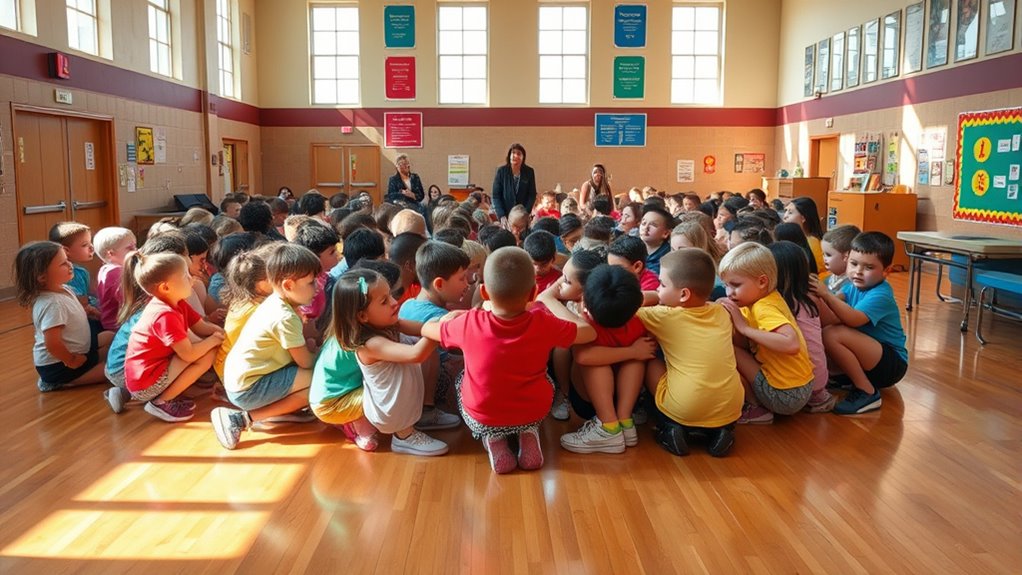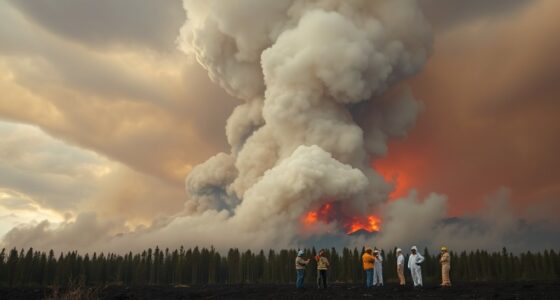In Tornado Alley schools, child safety drills are essential for preparing students for severe weather. These drills happen at least twice a year, simulating real tornado situations to guarantee you know how to respond. Notification triggers immediate action, and you follow specific evacuation procedures. After each drill, there’s a debrief to improve future safety. Engaging in these practices boosts your confidence and readiness for real emergencies, and there’s much more to explore about these important safety measures.
Key Takeaways
- Schools in Tornado Alley conduct regular safety drills to prepare students for potential tornado threats and ensure child safety.
- Drills simulate tornado warnings, with students practicing evacuation to designated safe areas like hallways or specific rooms.
- Communication during drills is essential, helping students and staff understand procedures and maintain silence for effective execution.
- Debriefing sessions after drills allow for evaluation, feedback, and continuous improvement of safety protocols in collaboration with local agencies.
- Regular drills increase student confidence and readiness for real tornado events, fostering a culture of safety within schools.

In the heart of Tornado Alley, schools prioritize child safety through regular drills designed to prepare students and staff for severe weather emergencies. You’ll find these drills conducted at least twice a year, usually in the fall and spring, making certain everyone’s ready when the storm hits. The primary goal is to simulate a tornado warning response, giving you and your classmates the experience needed to react appropriately during an actual event.
When the drill begins, you’ll receive an initial notification about severe weather, followed by a simulated tornado warning. This is your cue to spring into action. You’ll follow designated evacuation routes, leading you to safe areas like hallways or specific rooms. The emphasis during these drills is on silence and following your teacher’s instructions. Smaller rooms, such as bathrooms, might even be used if they offer better protection than hallways. The importance of communication can’t be overstated; schools use established systems to send alerts and instructions, making sure everyone is informed.
Drills typically start with a severe weather alert, progressing to a warning, and concluding with an “all clear” message. School administrators and emergency management officials coordinate these exercises, making sure everything runs smoothly. You’ll participate in every drill, with the objective of testing preparedness and identifying vulnerabilities. Afterward, there’s often a debriefing session to discuss what went well and what could be improved.
Living in Tornado Alley means you face unique risks. Historical tornado events have shown the critical need for safe refuge areas in schools. Case studies of past incidents continually refine safety protocols and help identify the safest spots within your school. Federal, state, and local agencies collaborate to make certain that safety standards are up to date and effective.
While drills are essential, challenges exist. Some schools mightn’t have ideal safe rooms, which can complicate evacuation efforts. Yet, these limitations only reinforce the importance of drills. Your school’s commitment to child safety means they actively seek feedback from participants like you. This feedback loop helps improve future drills, making sure everyone understands the purpose and procedures.
In the end, these drills aren’t just about following orders; they’re about equipping you with the knowledge and skills needed to stay safe during a tornado. By practicing regularly, you can feel more confident and prepared when the real thing happens.
Frequently Asked Questions
How Often Will These Drills Be Conducted in Schools?
You can expect these drills to be conducted multiple times a year, typically during the fall and spring.
Schools aim to align the drills with peak tornado seasons, ensuring everyone’s prepared. By repeating the drills, you’ll help identify any issues in procedures.
Customization based on your school’s layout is essential, and regional regulations may affect how often drills occur.
Regular practice keeps everyone familiar with safety protocols and enhances overall readiness.
Are Parents Notified Before a Drill Takes Place?
You hear the siren blare, your heart races, and you wonder—do you know what’s happening?
Yes, parents are usually notified before a drill takes place. Schools send out letters or messages explaining the drill’s purpose and procedures, so you won’t panic when the alarm goes off.
This communication helps you support your child during these exercises, keeping everyone calm and informed while ensuring that safety measures are understood and practiced effectively.
What Is the Age-Appropriate Way to Explain Drills to Children?
When explaining drills to children, you want to keep it simple and reassuring. Use gentle language to discuss the importance of safety without causing fear.
Tailor your explanation based on their age; younger kids need basic steps, while older ones can handle more details. Encourage questions to help them feel involved.
Reassure them about adult roles during emergencies, and use visuals to make the information clearer. Regular practice boosts their confidence!
Will There Be Any Follow-Up After the Drills Are Completed?
Absolutely, there’ll be a delightful follow-up after the drills!
Once the excitement settles, you’ll gather with everyone to chat about the experience. This is your chance to share thoughts and ideas, making things even better for next time.
You’ll help highlight what worked and what didn’t, ensuring everyone feels confident and safe. Schools love to hear your feedback, reinforcing the importance of these practices while keeping the atmosphere positive and engaging.
Are There Resources Available for Parents to Discuss Tornado Safety?
Yes, there are plenty of resources available for you to discuss tornado safety with your children.
Organizations like the American Red Cross provide educational materials and guides. You can also find interactive websites and apps that teach kids about tornado preparedness in a fun way.
Local emergency management offices often offer workshops or information sessions. Engaging in conversations and practicing safety plans together helps reinforce what they need to know during an emergency.
Conclusion
As the storm clouds gather and the winds whisper ominously, you can’t shake the feeling of uncertainty. But when the alarm sounds, you remember the drills—the practiced movements, the calming instructions. You and your classmates huddle together, listening intently, hearts racing. Will this be just another drill, or will it be a test of your courage? In those tense moments, you realize that preparation can make all the difference, and you’re ready to face whatever comes next.










